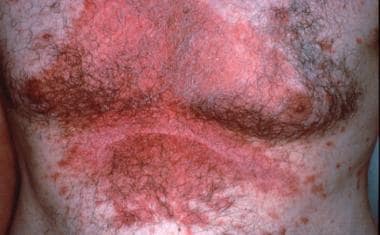That red, itchy rash on your scalp that has flaky scales could be seborrheic dermatitis, or seborrhea. It’s a common skindisease that looks similar to psoriasis, eczema, or an allergic reaction. And it can appear on your body as well as your scalp.
Causes
We don’t know what exactly causes seborrheic dermatitis. It seems to be a combination of things, including:
- Stress
- Your genes
- A yeast that normally lives on skin
- Certain medical conditions and medicines
- Cold, dry weather
It doesn’t come from an allergy or being unclean.
Newborns and adults aged 30-60 are more likely to get seborrheic dermatitis. It’s more common in men than women and in people with oily skin. These medical conditions can also raise your risk:
- Acne
- AIDS
- Alcoholism
- Depression
- Eating disorders
- Epilepsy
- Heart attack or stroke recovery
- Parkinson’s disease
- Psoriasis
- Rosacea
Symptoms
Dandruff and cradle cap are common names for seborrheic dermatitis. Babies 3 months and younger often get cradle cap: crusty yellow or brown scales on their scalp. It usually goes away before they’re a year old, although it can come back when they reach puberty.
You might get seborrheic dermatitis on your face, especially around your nose, on your eyelids, or behind your ears. It can show up on your body, too:
- In the middle part of the chest
- Around the navel
- On buttocks
- In skin folds under arms and on legs
- In the groin
- Below breasts
On babies, seborrheic dermatitis might be mistaken for diaper rash.
Skin can itch, burn, or look red. The scales that flake off could be white or yellowish and look moist or oily.
Because it can look like other skin conditions, you should see your family doctor to get a diagnosis and the right treatment. The dermatologist will ask about your medical history and look at your skin. You may need other tests if the doctor thinks it’s related to another medical condition.

Treatment
Sometimes, seborrheic dermatitis will clear up by itself. More often, it’s a lifelong issue that clears and flares. It can last for years at a time, but you can usually control it with good skin care.
Adults with seborrheic dermatitis on their scalp can use an over-the-counter dandruff shampoo that contains one of these key ingredients:
- Coal tar
- Ketoconazole
- Salicylic acid
- Selenium sulfide
- Zinc pyrithione
For infants with cradle cap, shampoo their scalp daily with warm water and baby shampoo. If that doesn’t help, talk to your pediatrician about medicated shampoos before you try one. A dandruff shampoo could irritate your baby’s scalp. To soften thick patches first, rub mineral oil onto the area and brush gently with a baby hairbrush to help peel the scales off.
On the face and body, keep the affected areas clean wash with soap and water every day. Sunlight may stop the growth of the yeast organisms that inflame the skin, so being outdoors and outdoor exercise could help make the rash go away. Always be sure to wear sunscreen.
Other treatments include:
- Antifungal products
- Corticosteroid lotions
- Prescription-strength medicated shampoos
- Sulfur products
Often the best results come from a combination of treatments, both medication and lifestyle.
Work with your doctor or pediatrician if you’re using a treatment other than shampoo, since there could be side effects, especially if you use it for longer or more often than prescribed.
If your seborrheic dermatitis doesn’t get better, or if the area becomes painful, red, swollen, or starts to drain pus, see your doctor.

Post a comment